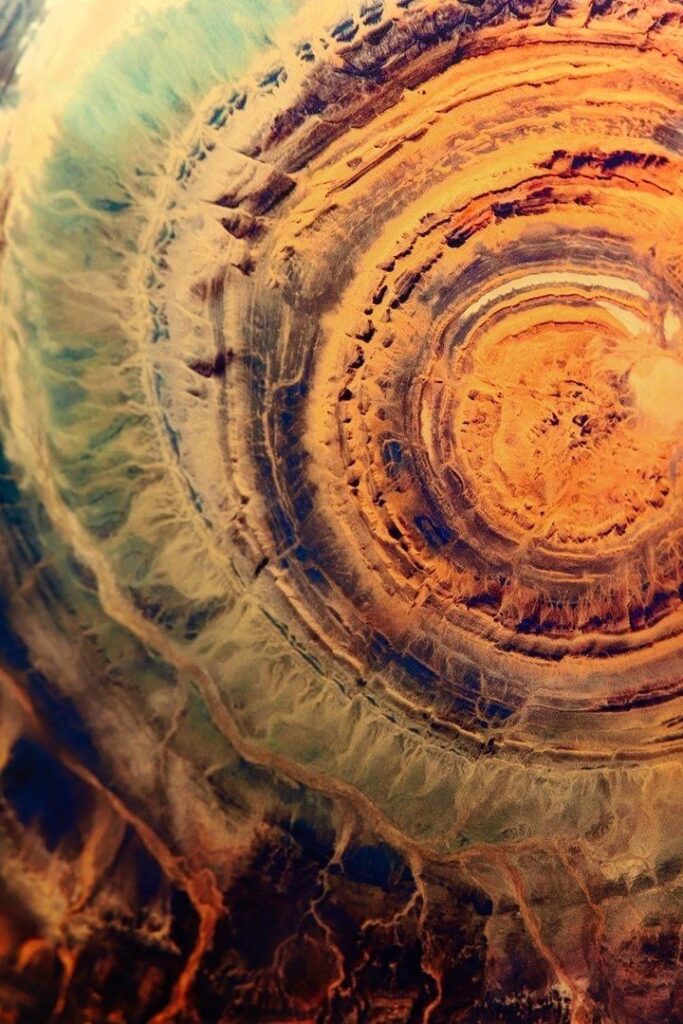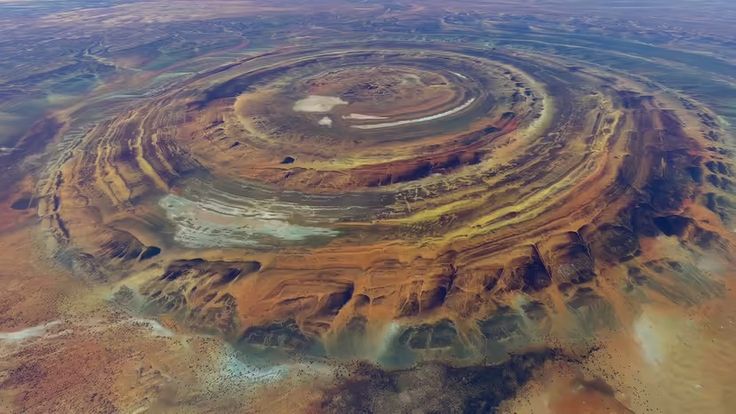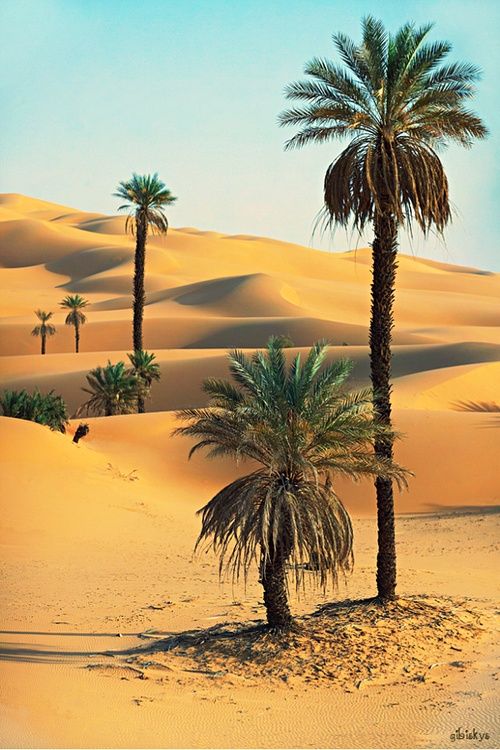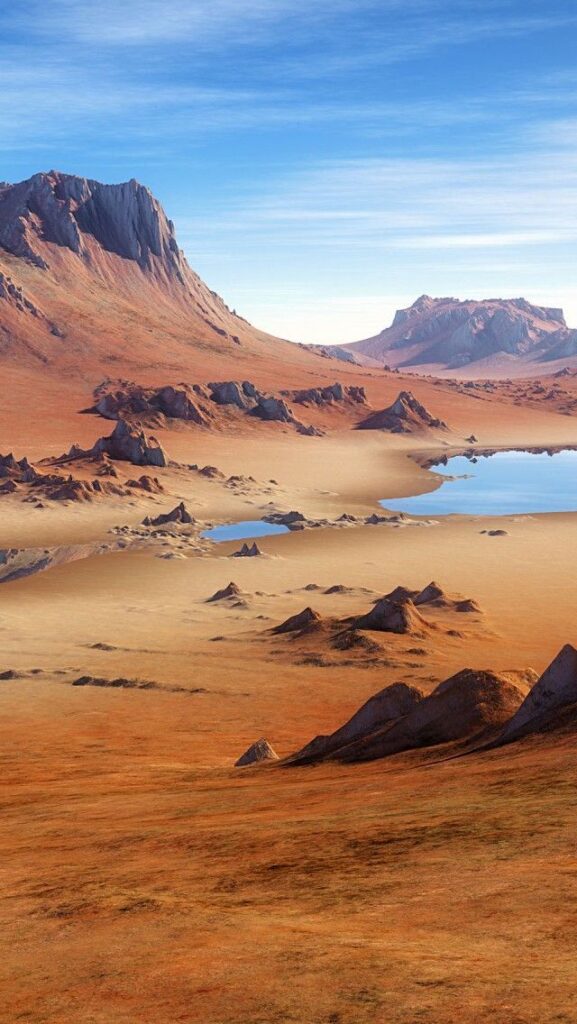Hidden deep in the vast expanse of Mauritania’s desert lies a natural wonder so immense it can only be fully appreciated from the sky. Known as the Eye of the Sahara, or the Richat Structure, this giant circular formation stretches across forty kilometers of sand and stone. From above, it resembles a colossal bull’s-eye carved into the Earth, its concentric rings radiating across the golden landscape of the Sahara. For astronauts orbiting the planet, it has long been a guiding landmark, one of the few natural features easily visible from space. On the ground, the Eye becomes a rugged landscape of ridges and valleys, where time and nature have left their mark for millions of years.
The Desert’s Hidden Eye
The Sahara Desert is a place of extremes endless dunes, shifting winds, and an unforgiving climate. Yet amid this vast monotony, the Eye emerges like a secret written into the desert’s surface. Located near the ancient caravan town of Ouadane in Mauritania, the structure breaks the horizon with its almost perfect circular design. To the traveler who reaches its edge, the Eye feels less like a geological formation and more like a colossal amphitheater, a ringed monument carved not by human hands but by forces older than civilization itself.

From space, the Eye reveals its full majesty. Its circles are painted in earthy reds, deep browns, and pale ochres, the product of rock layers that date back billions of years. Astronauts aboard Gemini, Apollo, and later the International Space Station have photographed it countless times, using it as both a landmark and a source of wonder. For them, the Eye is more than just a geological structure it is a symbol of Earth’s raw beauty as seen from the heavens.
A Geological Puzzle and a World of Legends
For decades, the origins of the Eye of the Sahara were cloaked in mystery. Its shape seemed too precise, too symmetrical, to be anything other than the scar of a massive meteorite impact. Yet when geologists examined it more closely, the evidence told a different story. Instead of being an impact crater, the Eye was revealed to be a geological dome—layers of rock pushed upward by tectonic movements long ago. Over the course of hundreds of millions of years, erosion by wind and water sculpted away the softer rock, leaving behind the harder layers in rings. What remains today is a vast natural target in the desert, each ring marking a chapter of Earth’s ancient history.

The rocks of the Eye are among the oldest on Earth, some dating back more than two billion years. They bear the imprint of vanished seas, shifting continents, and climates long forgotten. But while science explains its structure, myths have always lingered. Perhaps the most famous theory links the Eye to Atlantis, the legendary city described by Plato. His writings speak of a city formed in concentric rings of land and water, a description many see mirrored in the Richat Structure’s design. Though no evidence of human settlement has ever been uncovered within its rings, the resemblance keeps the theory alive, fueling documentaries and debates around the world.
Local legends, too, give the Eye a mystical presence. To some, it is a spiritual landmark, a doorway to the heavens carved into the desert. To others, it is a reminder of forces beyond human understanding, a sacred circle left behind by the Earth itself. Between science and myth, the Eye remains a place where geology and imagination meet.
Journey to the Heart of the Eye
Reaching the Eye of the Sahara is no easy task. The structure lies far from major cities, deep within Mauritania’s desert, accessible only by long journeys across harsh terrain. Most who visit travel from Atar or Ouadane in rugged vehicles, guided by locals who know the desert’s secrets. The journey itself is part of the adventure, with shifting sands, rocky outcrops, and wide horizons stretching endlessly in all directions.

Standing within the Eye, the scale is overwhelming. The ridges rise like frozen waves, their arcs bending into perfect circles that seem to stretch beyond sight. Valleys cut through layers of ancient stone, their colors shifting with the movement of the sun. At dusk, the desert sky burns orange and red, and the Eye glows as though lit from within. It is a place of silence, of vastness, where the only sounds are the wind and the echo of one’s own footsteps.

Today, the Eye attracts scientists, adventurers, and curious travelers alike. For researchers, it is a natural laboratory, offering insight into Earth’s geological past. For tourists, it is an unforgettable spectacle remote, humbling, and almost otherworldly. And for the people of Mauritania, it is both a treasure of the land and a mystery that continues to inspire awe.
The Eye of the Sahara remains one of the planet’s most remarkable wonders. Whether seen as a geological marvel, a possible echo of ancient myths, or a breathtaking landmark in the desert, it continues to capture the human imagination. From orbit, it is a guiding mark in the endless sands. From the ground, it is a monument to time itself. And for those who stand before it, the Eye is a reminder that the Earth still holds mysteries as grand and as beautiful as any legend ever told.





